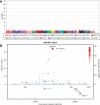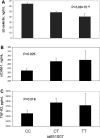Genetic variants in ABO blood group region, plasma soluble E-selectin levels and risk of type 2 diabetes
- PMID: 20147318
- PMCID: PMC2850622
- DOI: 10.1093/hmg/ddq057
Genetic variants in ABO blood group region, plasma soluble E-selectin levels and risk of type 2 diabetes
Abstract
Blood soluble E-selectin (sE-selectin) levels have been related to various conditions such as type 2 diabetes. We performed a genome-wide association study among women of European ancestry from the Nurses' Health Study, and identified genome-wide significant associations between a cluster of markers at the ABO locus (9q34) and plasma sE-selectin concentration. The strongest association was with rs651007, which explained approximately 9.71% of the variation in sE-selectin concentrations. SNP rs651007 was also nominally associated with soluble intracellular cell adhesion molecule-1 (sICAM-1) (P = 0.026) and TNF-R2 levels (P = 0.018), independent of sE-selectin. In addition, the genetic-inferred ABO blood group genotypes were associated with sE-selectin concentrations (P = 3.55 x 10(-47)). Moreover, we found that the genetic-inferred blood group B was associated with a decreased risk (OR = 0.44, 0.27-0.70) of type 2 diabetes compared with blood group O, adjusting for sE-selectin, sICAM-1, TNF-R2 and other covariates. Our findings indicate that the genetic variants at ABO locus affect plasma sE-selectin levels and diabetes risk. The genetic associations with diabetes risk were independent of sE-selectin levels.
Figures



References
-
- Blann A., Seigneur M. Soluble markers of endothelial cell function. Clin. Hemorheol. Microcirc. 1997;17:3–11. - PubMed
-
- Meigs J.B., Hu F.B., Rifai N., Manson J.E. Biomarkers of endothelial dysfunction and risk of type 2 diabetes mellitus. JAMA. 2004;291:1978–1986. - PubMed
-
- Stranges S., Rafalson L.B., Dmochowski J., Rejman K., Tracy R.P., Trevisan M., Donahue R.P. Additional contribution of emerging risk factors to the prediction of the risk of type 2 diabetes: evidence from the Western New York Study. Obesity (Silver Spring) 2008;16:1370–1376. - PubMed
Publication types
MeSH terms
Substances
Grants and funding
- U01HG004446/HG/NHGRI NIH HHS/United States
- P01CA087969/CA/NCI NIH HHS/United States
- U01HG004738/HG/NHGRI NIH HHS/United States
- P01CA055075/CA/NCI NIH HHS/United States
- CAPMC/ CIHR/Canada
- U01HG04424/HG/NHGRI NIH HHS/United States
- U01HG004729/HG/NHGRI NIH HHS/United States
- RFAHG006033/PHS HHS/United States
- R01 HL71981/HL/NHLBI NIH HHS/United States
- DK46200/DK/NIDDK NIH HHS/United States
- U01HG004726/HG/NHGRI NIH HHS/United States
- U01HG004438/HG/NHGRI NIH HHS/United States
- U01HG004415/HG/NHGRI NIH HHS/United States
- U01HG004735/HG/NHGRI NIH HHS/United States
- U01HG004728/HG/NHGRI NIH HHS/United States
- U01HG004399/HG/NHGRI NIH HHS/United States
- U01HG004402/HG/NHGRI NIH HHS/United States
- U01HG004422/HG/NHGRI NIH HHS/United States
- U01DE018993/DE/NIDCR NIH HHS/United States
- U01HG004423/HG/NHGRI NIH HHS/United States
- R01DK058845/DK/NIDDK NIH HHS/United States
- HHSN268200782096C/HG/NHGRI NIH HHS/United States
- U01DE018903/DE/NIDCR NIH HHS/United States
- R01 HL071981/HL/NHLBI NIH HHS/United States
- U01HG004436/HG/NHGRI NIH HHS/United States
LinkOut - more resources
Full Text Sources
Medical

